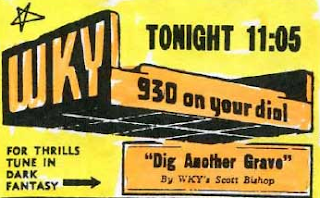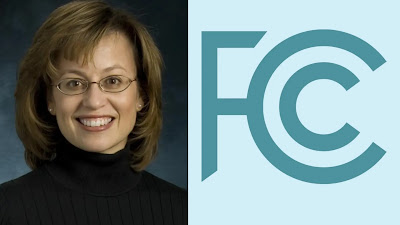 |
| Mercedes McCamdridge |
She had lead roles in many of his Mercury Theatre broadcasts in the 1930’s while starring on Broadway. She guested on numerous radio dramas (Lights Out, Inner Sanctum, Studio One, Bulldog Drummond, Ford Theatre, Gang Busters, Abie’s Irish Rose, etc.) and had lead roles in both East and West Coast originations of I Love a Mystery.
Later she had a healthy career in TV, and won a Best Supporting Actress Oscar for All the King’s Men.
 |
| Print Ad 1944 |
"5XT" became the 87th licensed station in the United States on March 16, 1922. It was owned by the Oklahoma Radio Shop (Earl C. Hull & H.S. Richards). The station was assigned the WKY call letters and began broadcasting weekdays from noon to 1:00 P.M. and from 7:30 to 9:30 P.M. On Sundays, WKY was on the air from 3 to 4 P.M. and 7:30 to 9:30 P.M.
On November 1922, WKY announced a "silent night" policy, meaning the station would broadcast only four, and later three nights a week. This was so listeners could have a chance to tune into other stations in neighboring states.
Richards and Hull struggled to keep WKY on the air. In late 1925, Richards left the radio business, but Hull continued to keep WKY on the air by selling shares of the station to radio dealers in Oklahoma City. The dealers paid Hull a small salary to keep the station broadcasting; however they decided the financial drain had become too much. In 1928, WKY was purchased by the Oklahoma Publishing Company, publishers of the Daily Oklahoman for the hefty sum of $5,000 (over $63,000 in 2010 dollars).
The formal opening of the new WKY was set for November 11, 1928, but the station went on the air several days earlier to carry the presidential election returns as Herbert Hoover won in a Republican landslide.
By the following year, WKY was attempting to operate like the powerhouse stations in the east. Aside from the programming from NBC, everything broadcast by WKY originated locally.
In 1958, WKY became the second Top-40 formatted station in Oklahoma City, behind KOCY, (now KEBC). During the 1960s and 70's WKY fended off serious challenges from 50,000 watt rival KOMA 1520 AM.
Although KOMA was very famous outside Oklahoma City, due to its large nighttime signal (like WABC in New York), WKY was usually the ratings leader in the city itself (as WMCA won New York City ratings books from 1963–1966); WKY continued to top many Arbitron ratings sweeps into the 1970s.
Ironically, WKY mainstays during that time—Danny Williams, Ronnie Kaye and Fred Hendrickson—would go on to become "KOMA Good Guys" when the station flipped from a standards to an oldies format.
Today, WKY is owned by Cumulus and simulcasts it's sister station WWLS.
➦In 1925...Chester Rice and Edward Kellogg designed the dynamic loudspeaker, a significant advancement in audio technology. This invention improved the quality of sound reproduction for radio broadcasts, making listening experiences clearer and more enjoyable for audiences. The dynamic loudspeaker became a foundational technology for radio and other audio systems, shaping the future of broadcasting.
➦In 1926...Joseph Levitch aka Jerry Lewis was born (Died – August 20, 2017). He was a comedian, actor, singer, director, producer, screenwriter and humanitarian, whose career spanned eight decades and was nicknamed "The King of Comedy". He was known for his partnership with Dean Martin as the groundbreaking act of Martin and Lewis.
Lewis went on to star in, write, produce and direct many motion pictures, such as The Delicate Delinquent, The Sad Sack, Rock-A-Bye Baby, The Geisha Boy, Don't Give Up The Ship, Visit to a Small Planet, Cinderfella, The Bellboy, The Ladies' Man, The Errand Boy, It's Only Money, The Nutty Professor, Who's Minding the Store?, The Patsy, The Disorderly Orderly and The Family Jewels. He would also appear in concert stages, nightclubs, music recordings and television.
 |
| Martin & Lewis |
Lewis initially gained attention as part of a double act with singer Dean Martin, who served as straight man to Lewis' zany antics as the Martin and Lewis comedy team. They were different from other duo acts of the time because they played to each other and had ad-libbed improvisational segments within their planned routines.
After forming in 1946, they quickly rose to national prominence, first with their popular nightclub act, then as stars of The Martin and Lewis Show on the radio NBC Red Network. The two made appearances on early live television on their June 20, 1948 debut broadcast on Toast of the Town (later renamed as The Ed Sullivan Show on September 25, 1955) on CBS. This was followed on October 3, 1948, by an appearance on NBC's Welcome Aboard.
In 1950, Martin and Lewis signed with NBC to be one of a series of weekly rotating hosts of The Colgate Comedy Hour, a live Sunday evening broadcast. Lewis, writer for the team's nightclub act, hired Norman Lear and Ed Simmons as regular writers for their Comedy Hour material. Their Comedy Hour shows consisted of stand-up dialogue, song and dance from their nightclub act and movies, backed by Dick Stabile's big band, slapstick and satirical sketch comedy, Martin's solo songs, and Lewis' solo pantomimes or physical numbers.
As one of the most successful performers in show business, with worldwide box office receipts of his films in excess of $800 million, Lewis received global acclaim for his unique ability and style with both comedy and drama. As part of Martin and Lewis and as a solo actor, he was voted Hollywood's top box-office draw from 1951 to 1965, in later years as the sole comedian.
➦In 1927...Richard "Dick" Beals was born (Died at age 85 – May 29, 2012). He was an American actor and voice actor, who performed many voices in his career, which spanned the period from the early 1950s into the 21st century. Beals specialized in doing the voices of young boys, although he was also hired to voice young female children.
Perhaps his most recognizable characterization was the voice of the stop-motion animation figure called "Speedy Alka-Seltzer", featured in television commercials for more than 50
 |
| Dick Beals |
In January 1949, as a senior at MSU, Beals got a call to do a radio commercial for WXYZ, Detroit. After the show, the director asked him to be on call for all the children's voices as well as those of small, talking animals on all three network radio shows produced by WXYZ - The Lone Ranger, Green Hornet and Challenge of the Yukon.
In 1952, after performing in an episode of The Green Hornet, WXYZ station manager Jack McCarthy referred Beals to Forrest Owen of Wade Advertising. Owen showed Beals a rendering of a proposed product spokesman for their client, Alka-Seltzer and had him record a voice audition. Four months later, Beals was notified that he had been selected as the voice for Speedy Alka-Seltzer as well as the voice of Sticky, the Vaseline mascot.
Beals moved to Los Angeles where he continued making commercials as Speedy Alka-Seltzer and also provided voices for other commercials, such as Alka-Seltzer, Oscar Mayer, the Campbell Soup Kids, and Bob's Big Boy. Beals recorded his first Speedy Alka-Seltzer television commercial in 1953, doing a total of 225 in his career.
➦In 1929...WHP-AM, Harrisburg, Pennsylvania signed-on.








































